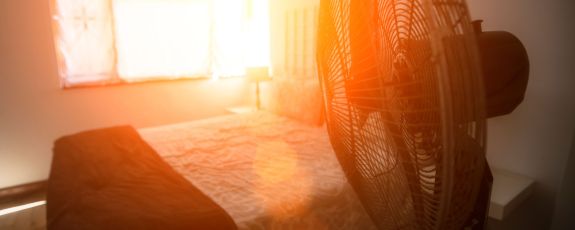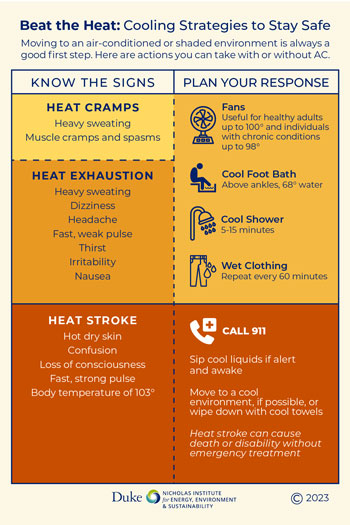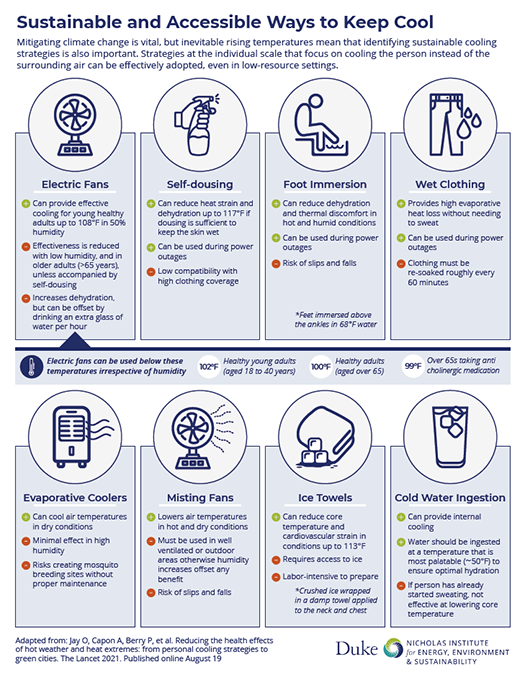
Severe Heat Arrives. Here’s What’s Important for Living Under Dangerous Conditions
Plus: Duke guidelines on working outside in severe heat
This is a template for dangerous conditions for humans, particularly those working outside for any extensive amount of time, and a good moment to recall that heat is the number one weather-related killer in the United States. The range of heat-related illnesses includes heat cramps, heat exhaustion and heat stroke – and heat can also strain many other systems within the body, exacerbating other health conditions.
But Duke experts at the Nicholas Institute for Energy, Environment & Sustainability have advice for surviving severe heat. In a short video, Ashley Ward, director of Duke’s Heat Policy Innovation Hub, provides 10 tips for protecting yourself from heat-related illness.
Cooler evenings are essential for the body to recover from the stresses of daytime severe heat. “Your body needs a reprieve,” Ward told the Associated Press last week. “You don’t get that overnight, we start the next day at a deficit.”

When overnight temperatures do not drop below 75 degrees, she said, “you start to see some pretty extraordinary outcomes with respect to heat illness and heat stroke, and even mortality.”
While there is still much to understand about severe heat and its impacts on the body, research has grown significantly this past decade. Duke researchers from across the university are contributing to analysis of heat’s impacts on human health and the economy – as well as potential solutions. Ashley Ward and the Heat Policy Innovation Lab have received national attention for work advising decisionmakers in government, the private sector and civil society.
One of Ward’s messages is that 2025 will bring the coolest summer of the remainder of our lifetimes. The trend toward a warming climate isn’t going to be changing anytime soon.
She advises that people start dealing with heat as a year-round, long-term effort rather than reacting to it as it arises. “Government, companies, and community organizations must start working together on developing the strategies, tools, and partnerships needed to reduce heat exposure and enhance resilience,” Ward explained in an interview with Duke Today. “Through the hub, Duke is helping catalyze promising collaborations to effectively protect people and the economy.”
The hub is working on this challenge at the national and international levels — as well as locally. For example, in 2024, the hub partnered with state agencies to release a Heat Action Plan Toolkit featuring a template that each of North Carolina’s 100 counties can customize to fit their specific needs and circumstances.
The toolkit also includes outreach resources for communities, as well as recommended actions for health care staff and local leaders when extreme heat is in the forecast.
In 2025, the hub helped state agencies improve the precision of the North Carolina Heat Health Alert System, which citizens, local businesses and government officials can use to assess heat’s localized risks to health.
Outdoor Work at Duke
Managing heat is a top priority for Duke Facilities and other university units where employees are working outside. The university also collaborates with independent contractors to take similar steps to protect workers doing construction and other outdoor activities.
Here are key points of Duke Facilities heat guidelines:
• We adjust schedules so teams can arrive earlier, allowing them to start and finish their workday sooner
• Employees have the freedom to evaluate their own needs regarding extreme heat
• We supply water and ensure access to indoor break room facilities where employees can complete safety training or fulfill other indoor responsibilities
• Managers remain attentive to ongoing work and focus on scheduling the more demanding tasks during the cooler, earlier hours of the day
• Our outdoor employees possess a heightened awareness of their limits, enabling them to better recognize when to hydrate, take breaks and effectively manage the heat.
